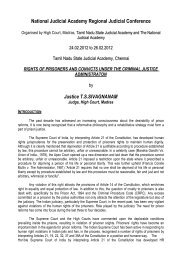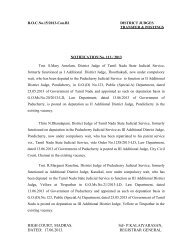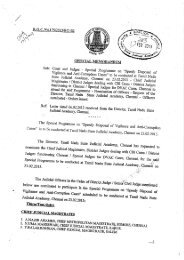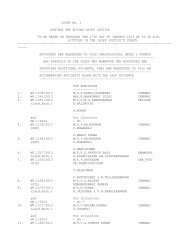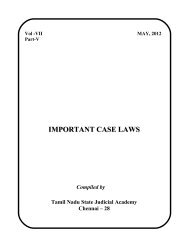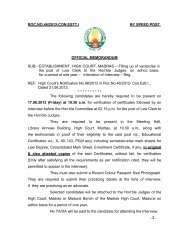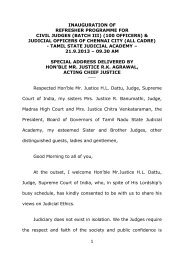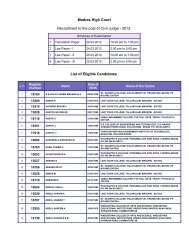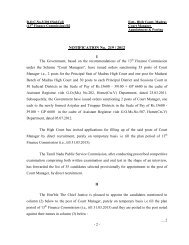Appreciation of Evidence in Sessions Cases - Justice D.Murugesan
Appreciation of Evidence in Sessions Cases - Justice D.Murugesan
Appreciation of Evidence in Sessions Cases - Justice D.Murugesan
Create successful ePaper yourself
Turn your PDF publications into a flip-book with our unique Google optimized e-Paper software.
necessarily be made to a Magistrate and when such statement is recorded by a Magistrate<br />
there is no specified statutory form for such record<strong>in</strong>g. Consequently, what evidential value or<br />
weight has to be attached to such statement necessarily depends on the facts and<br />
circumstances <strong>of</strong> each particular case. What is essentially required is that the person who<br />
records a dy<strong>in</strong>g declaration must be satisfied that the deceased was <strong>in</strong> a fit state <strong>of</strong> m<strong>in</strong>d.<br />
Where it is proved by the testimony <strong>of</strong> the Magistrate that the declarant was fit to make the<br />
statement even without exam<strong>in</strong>ation by the doctor the declaration can be acted upon<br />
provided the court ultimately holds the same to be voluntary and truthful. A certification by the<br />
doctor is essentially a rule <strong>of</strong> caution and therefore the voluntary and truthful nature <strong>of</strong> the<br />
declaration can be established otherwise.<br />
4. …..<br />
5. …. It is <strong>in</strong>deed a hypertechnical view that the certification <strong>of</strong> the doctor was to the effect<br />
that the patient is conscious and there was no certification that the patient was <strong>in</strong> a fit state <strong>of</strong><br />
m<strong>in</strong>d especially when the Magistrate categorically stated <strong>in</strong> his evidence <strong>in</strong>dicat<strong>in</strong>g the<br />
questions he had put to the patient and from the answers elicited was satisfied that the<br />
patient was <strong>in</strong> a fit state <strong>of</strong> m<strong>in</strong>d whereafter he recorded the dy<strong>in</strong>g declaration. ….”<br />
In a recent decision <strong>in</strong> Amol S<strong>in</strong>gh V. State <strong>of</strong> M.P. (2002 (5) SCC 468 that Hon’ble Apex Court<br />
has held as follows:<br />
“S.32(1) <strong>of</strong> the <strong>Evidence</strong> Act, 1872 – Dy<strong>in</strong>g Declaration – Evidentiary value – Multiple dy<strong>in</strong>g<br />
declarations – Inconsistencies – Discrepancies <strong>in</strong> the last dy<strong>in</strong>g declaration mak<strong>in</strong>g it doubtful<br />
– Held, it would not be safe to convict the appellant – Penal Code, 1860, Ss.302 and 34.<br />
Law relat<strong>in</strong>g to appreciation <strong>of</strong> evidence <strong>in</strong> the form <strong>of</strong> more than one dy<strong>in</strong>g<br />
declaration is well settled. Accord<strong>in</strong>gly, it is not the plurality <strong>of</strong> the dy<strong>in</strong>g declarations but the<br />
reliability there<strong>of</strong> that adds weight to the prosecution case. If a dy<strong>in</strong>g declaration is found to<br />
be voluntary, reliable and made <strong>in</strong> fit mental condition, it can be relied upon without any<br />
corroboration. The statement should be consistent throughout. If there are more than one<br />
dy<strong>in</strong>g declaration they should be consistent. However, if some <strong>in</strong>consistencies are noticed<br />
between one dy<strong>in</strong>g declaration and the other, the court has to exam<strong>in</strong>e the nature <strong>of</strong> the<br />
<strong>in</strong>consistencies, <strong>in</strong> such a situation, the court has to exam<strong>in</strong>e the same <strong>in</strong> the light <strong>of</strong> the<br />
various surround<strong>in</strong>g facts and circumstances.<br />
On facts, it would be unsafe to convict the appellant. The discrepancies make the last<br />
declaration doubtful. The nature <strong>of</strong> the <strong>in</strong>consistencies is such that they are certa<strong>in</strong>ly<br />
material. The High Court had itself observed that the dy<strong>in</strong>g declaration (Ex.t.P-11) scribed by<br />
the Executive Magistrate (PW 9) at about 0435 hours <strong>in</strong> the same night was not <strong>in</strong> conformity<br />
with the FIR and the earlier dy<strong>in</strong>g declaration (Ext.P-3) scribed by ASI, B (PW 8) <strong>in</strong>s<strong>of</strong>ar as<br />
different motives have been described. That is not only variation. There are several other<br />
discrepancies, even as regards the manner <strong>in</strong> which she is supposed to have been spr<strong>in</strong>kled<br />
with kerosene and thereafter set fire on her.”<br />
Section 32 – Dy<strong>in</strong>g Declaration – Recorded <strong>in</strong> translated version – Reliability – Declaration made by<br />
deceased <strong>in</strong> Telugu – translated by the duty doctor <strong>in</strong> Tamil and recorded by the Magistrate <strong>in</strong> Tamil –<br />
21



